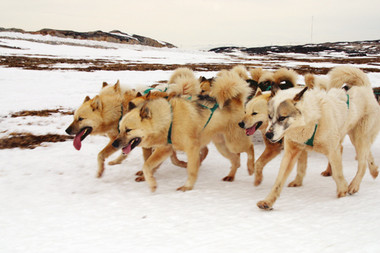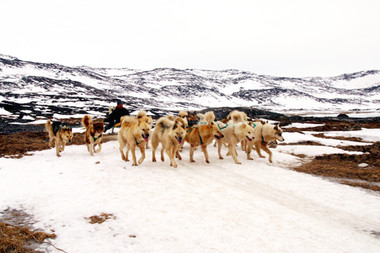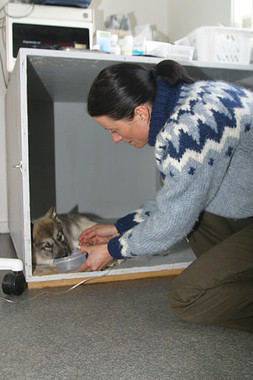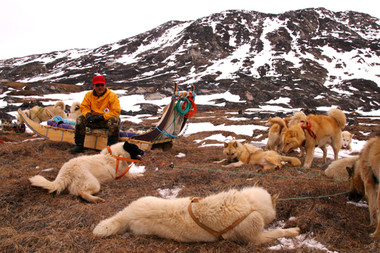Teaching New Tricks in Greenland
November 26, 2006 - The Santa Fe New Mexican

ILULISSAT, Greenland—The idea of “a dog’s life†takes on new meaning here.
Forged by history, tradition and unflinching elements, life for Greenland’s sled dogs is about as rough as it gets. Though life isn’t easy, a clear bond exists between dog and owner, and the dogs are an essential part of life on the island.
These are not pampered pets. But one veterinarian is beginning the slow process of showing owners how to treat their animals as humanely as possible.
On the trail, there is an undeniable link between the dogs, their owner and the nature that surrounds them. Whether at work or out for fun, riding with the dogs is, as one enthusiast puts it, “like roller coasting through heaven.”
An owner’s only instructions to his passengers tend to be on the order, “Get on,” and “Hang on.” And with a jerk, his dogs take off, pulling the sled behind them with a group of nylon ropes that look like tangled spaghetti.
It’s a magnificent, primal experience. Sitting sidesaddle across the front of the sled, the driver occasionally barks out commands like “Iu, iu, iu, iu!” for “Left!” and “Ili, ili, ili, ili!” for “Right!”—punctuating any that go unheeded with a crack of the whip in the air.
 Sled dogs are a vital part of life in Greenland — far safer and more efficient for hunting and fishing
Sled dogs are a vital part of life in Greenland — far safer and more efficient for hunting and fishing
than snowmobiles. Greenlanders don’t view their dogs as pets, but as beasts of burden. One veterinarian is starting to change that attitude, showing how a little TLC can improve a dog’s performance in front of the sled.Photo by Joe Ray
Deviation is not tolerated and any dog that misbehaves or falls behind on the trail gets an amazingly accurate lash on its rear end. How the owner manages not to flog himself or his passengers seems best thought about after the ride is over.
Whips or no, out on the trail is where it’s easiest to see the interdependence between the dogs and their owner. Along with the treats the dogs receive while there, they are clearly rewarded just by being out in the snow with their pack and their master.
Here, it’s also easy to understand polar explorer Knud Rasmussen’s quote: “Give me winter; give me dogs; you can keep the rest.”
“They’re working dogs,” explains Niels Chemnitz, a tour operator in the southern town of Kangerlussuaq. “They live outdoors all their lives.”
Driving an enormous old Mercedes-Benz military truck along icy roads, Chemnitz pulls up to a dog yard that looks like a deserted ranch, complete with a group of reindeer skulls on a shed roof.
A pair of puppies immediately runs up to say hello, and though they are exceedingly ripe-smelling, they’re about as cute as it gets. Scores of other, older dogs inside a large pen come as close as their chains let them.
“Don’t touch the big ones,” Chemnitz warns. “You might lose a finger.” Though he’s smiling, he’s not joking.
To get a better sense of the Greenland dogs’ place in this arctic landscape, the idea of keeping dogs as pets needs to be abandoned. Many here consider dogs to be tools, not unlike the way we think of mules, work horses or other farm animals.
The analogy is not as far off as it may seem. Though an outsider’s reflex may be to think of the dogs as a means of pulling a sled for tourists, dogs have been and continue to be a vital part of Greenlandic industry. Here in Ilulissat, population 5,005, hunting and fishing are two of the town’s biggest breadwinners, and to this day, dogs are an irreplaceable part of its inhabitants’ work. Inland, hunters use the dogs to hunt musk ox, seal and reindeer, all products that continue to clothe and nourish many of Greenland’s inhabitants. Similarly, halibut fishermen use the dogs to haul their catches back to town when they fish through the ice in Greenland’s fjords.
Not only is using them a tradition, the dogs are also considered the only way to continue these types of hunting and fishing. Talk to enough hunters and variations on one situation always comes up: “Imagine you’re in the middle of nowhere, and your snowmobile dies.” In a land this vast and frigid, it’s easy to see how quickly your goose would be cooked.
 Veterinary officer Marit Holm gives a drink of water to a dehydrated puppy. Holm estimates that about 70 percent of Greenland’s sled dogs are poorly treated. She travels the country teaching owners how to care for their dogs humanely. Photo by Joe Ray
Veterinary officer Marit Holm gives a drink of water to a dehydrated puppy. Holm estimates that about 70 percent of Greenland’s sled dogs are poorly treated. She travels the country teaching owners how to care for their dogs humanely. Photo by Joe Ray
If a dog is sick or injured, its owner will cut it free, knowing that most of the time it will be home when the rest of the pack returns.
In the fjord, with the dogs and sled relatively spread out (as opposed to everything concentrated in one spot on a snowmobile), it is less likely the fishermen, his catch or his dogs will go through the ice.
When the day is over, the dogs have been “rode hard and put up wet.” Some estimate that around 70 percent of Greenland’s dogs are treated inhumanely, statistics that helped push Greenland’s Home Rule Government to pass a July 2004 law for more humane treatment of animals.
Most dogs live chained to a rock, without a doghouse, sometimes getting into vicious fights. They often go undernourished, and though they can live well into their teens, many owners put theirs down after their third or fourth year, the age when they begin to get more cocky and less productive.
Though extremely difficult for dog-coddling Americans to understand, this is the way it has always been in Greenland. One veterinarian, however, is beginning to change things.
Marit Holm is a Norwegian-born veterinary officer based in Ilulissat. Working for Greenland, she tends to a few sick animals every day (the dogs’ veterinary care is paid for by the government, though their owners are in charge of paying for the medicine), but her primary work—the part that lends the “officer” to her job title—is to encourage more humane care of Greenland’s dogs.
 Out for a run at the end of the season, a sled dog driver and his pack take a break outside the
Out for a run at the end of the season, a sled dog driver and his pack take a break outside the
town of Ilulissat. Photo by Joe Ray
“(The owners) look at them as working dogs, and they often think that they shouldn’t have feelings for their dogs and that they shouldn’t be spoiled and that you should not give them too much love. Otherwise, they won’t be a good pulling dog. That’s their main rule,” she says.
After 14 years of dog sledding in Norway and two in Greenland, Holm disagrees. Politely.
“The Greenlandic dog should be a strong and big dog,” she said. “They love to pull the sled. They love to work. That’s when they are happy and glad dogs.”
She’s also remarkably Zen about a job that could easily be maddeningly frustrating. “I’m not angry with people. I’m just sad. I don’t think they do it to be cruel to the dogs,” she says. “If I can teach them something about keeping their dogs in a proper manner, that would be nice.”
About once a day, Holm goes into Ilulissat’s many dog yards, eventually checking out each canine to make sure it is receiving proper care.
“You have to start with the (children who are learning how to handle the dogs), teaching them to give the dogs enough food and water and take good care of them,” she says. “That’s where you have to start—how to treat your dog well.”
If a dog’s health falls below a certain level, Holm can also give the order to have the animal shot, an unfortunately clear motivator for owners to treat their animals well.
“You’re sitting there with a half-dead dog on your lap and wonder how their owner can do that,” she says. “I’d like to save all the dogs—I don’t want to put them down, but I don’t have a choice. I’m the reason many dogs are dead.”
Though it’s clear the attitudes of some of the hunters toward their dogs will never change, some progress is being made. She admits she’s been threatened “once or twice,” but she finds many of the dog owners receptive to changes that could endanger their livelihood.
She also leads by example, taking her own dogs out four to six times per week, sledding with them in the winter and jogging with them in the warmer months, along with providing each one with a brightly colored doghouse.
On a hike to the ancient village of Sermermiut, native guide Nive Heilmann stops in a dog yard to bring one of her dogs along on the walk—not something most other dog owners here would do.
“You can touch my dogs, but I wouldn’t touch the neighbors’ dogs. You might lose a finger,” she says. Her dogs, however, are a relatively happy bunch, and both dog and owner are clearly excited to be walking together.
“One of the best things about Greenland is that they have this tradition of dog sledding. It’s the last place on Earth where they use them this much,” Holm says. “I love sledding and working with the dogs. I burn for that.”